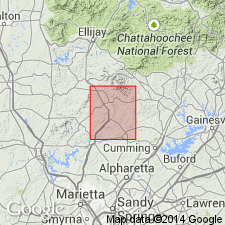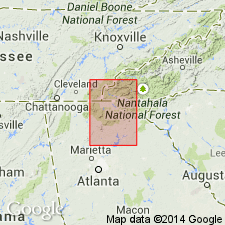
- Usage in publication:
-
- Marble Hill Hornblende Schist
- Modifications:
-
- Named
- Dominant lithology:
-
- Schist
- AAPG geologic province:
-
- Piedmont-Blue Ridge province
Summary:
Marble Hill Hornblende Schist, named in Tate quad., Pickens Co., northwestern GA, here described as calc-schists and biotite-hornblende schists. Thickness about 300 ft. Overlies Murphy Marble and underlies Andrews Schist. Strata included in Road Gneiss by Bayley (1928). Age is early Paleozoic.
Source: GNU records (USGS DDS-6; Reston GNULEX).

- Usage in publication:
-
- Marble Hill Hornblende Schist
- Modifications:
-
- Revised
- AAPG geologic province:
-
- Piedmont-Blue Ridge province
Summary:
Marble Hill Hornblende Schist here assigned to the base of the Mineral Bluff Group (rank raised). Directly overlies Murphy Marble or Brasstown Formation of Hiwassee River Group (new name). Underlies Mission Mountain Formation (new name). Most of unit is actually an amphibolite of volcanic origin, only locally schistose and calcareous. Marble Hill is an easily identifiable unit that marks a distinctive break between groups in the southwestern segment of the Murphy belt. The Andrews Schist (here abandoned) is not correlative with the Marble Hill despite similar stratigraphic position. The two units do not occur in the same region.
Source: GNU records (USGS DDS-6; Reston GNULEX).
For more information, please contact Nancy Stamm, Geologic Names Committee Secretary.
Asterisk (*) indicates published by U.S. Geological Survey authors.
"No current usage" (†) implies that a name has been abandoned or has fallen into disuse. Former usage and, if known, replacement name given in parentheses ( ).
Slash (/) indicates name conflicts with nomenclatural guidelines (CSN, 1933; ACSN, 1961, 1970; NACSN, 1983, 2005, 2021). May be explained within brackets ([ ]).

